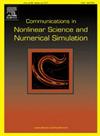Numerical modeling of stress state-dependent anisotropic fracture behavior for WE43 alloy
IF 3.4
2区 数学
Q1 MATHEMATICS, APPLIED
Communications in Nonlinear Science and Numerical Simulation
Pub Date : 2025-04-15
DOI:10.1016/j.cnsns.2025.108872
引用次数: 0
Abstract
Accurate prediction for fracture behavior plays an important role in metal forming process. The study aims to uncover and model the effect of anisotropy and stress state on the fracture behavior of WE43 alloy. The mechanical experiments along 0°, 45°, and 90° between the loading direction and rolling direction (RD, DD and TD) were carried out under tension, compression and shear stress states. It shows that the initial yield stress is with weak anisotropy and negligible tension-compression asymmetry, while the hardening behavior shows some anisotropy related to strain. The plastic ability along DD is preferred to that along RD and TD under uniaxial loading. The fracture behavior belongs to the ductile fracture with tension and shear mechanisms, which is dependent on the stress state and loading direction. An analytical anisotropic Drucker yield function is proposed to capture the evolving yield behavior with non-proportionality. The fracture-related variables from plane strain compression to plane strain tension along different loading directions are obtained with acceptable prediction accuracy by adopting the hybrid experimental-numerical method. A Drucker-DF2016 anisotropic fracture criterion is established based on the linear transformation tensor to characterize the coupling effect of anisotropy and stress state on the fracture behavior of WE43 alloy with an error of 0.054, which is smaller than the error (0.2908) of the Yld91-DF2014 anisotropic fracture criterion. The fracture location in numerical simulation is basically consistent with the fracture location in the experiment. This research provides an analytical yield function and anisotropic fracture model to be applied into the numerical modeling of the yield and fracture behaviors of metals.
WE43合金应力状态相关各向异性断裂行为数值模拟
断裂行为的准确预测在金属成形过程中起着重要的作用。本研究旨在揭示和模拟各向异性和应力状态对WE43合金断裂行为的影响。在拉伸、压缩和剪切应力状态下,分别进行了加载方向与轧制方向(RD、DD和TD)之间0°、45°和90°方向的力学实验。结果表明:初始屈服应力具有较弱的各向异性和可忽略的拉压不对称性,而硬化行为表现出与应变有关的一定的各向异性。单轴加载下,沿DD方向的塑性性能优于沿RD和TD方向的塑性性能。断裂行为属于韧性断裂,具有拉伸和剪切机制,与应力状态和加载方向有关。提出了一种解析性各向异性的德鲁克屈服函数,以捕捉具有非比例性的演化屈服行为。采用实验-数值混合方法,得到了不同加载方向上平面应变压缩到平面应变拉伸的断裂相关变量,预测精度较好。基于线性变换张量建立了Drucker-DF2016各向异性断裂准则,表征各向异性与应力状态对WE43合金断裂行为的耦合效应,该准则的误差为0.054,小于Yld91-DF2014各向异性断裂准则的误差0.2908。数值模拟中的断裂位置与实验中的断裂位置基本一致。本研究提供了一种可用于金属屈服和断裂行为数值模拟的解析屈服函数和各向异性断裂模型。
本文章由计算机程序翻译,如有差异,请以英文原文为准。
求助全文
约1分钟内获得全文
求助全文
来源期刊

Communications in Nonlinear Science and Numerical Simulation
MATHEMATICS, APPLIED-MATHEMATICS, INTERDISCIPLINARY APPLICATIONS
CiteScore
6.80
自引率
7.70%
发文量
378
审稿时长
78 days
期刊介绍:
The journal publishes original research findings on experimental observation, mathematical modeling, theoretical analysis and numerical simulation, for more accurate description, better prediction or novel application, of nonlinear phenomena in science and engineering. It offers a venue for researchers to make rapid exchange of ideas and techniques in nonlinear science and complexity.
The submission of manuscripts with cross-disciplinary approaches in nonlinear science and complexity is particularly encouraged.
Topics of interest:
Nonlinear differential or delay equations, Lie group analysis and asymptotic methods, Discontinuous systems, Fractals, Fractional calculus and dynamics, Nonlinear effects in quantum mechanics, Nonlinear stochastic processes, Experimental nonlinear science, Time-series and signal analysis, Computational methods and simulations in nonlinear science and engineering, Control of dynamical systems, Synchronization, Lyapunov analysis, High-dimensional chaos and turbulence, Chaos in Hamiltonian systems, Integrable systems and solitons, Collective behavior in many-body systems, Biological physics and networks, Nonlinear mechanical systems, Complex systems and complexity.
No length limitation for contributions is set, but only concisely written manuscripts are published. Brief papers are published on the basis of Rapid Communications. Discussions of previously published papers are welcome.
 求助内容:
求助内容: 应助结果提醒方式:
应助结果提醒方式:


